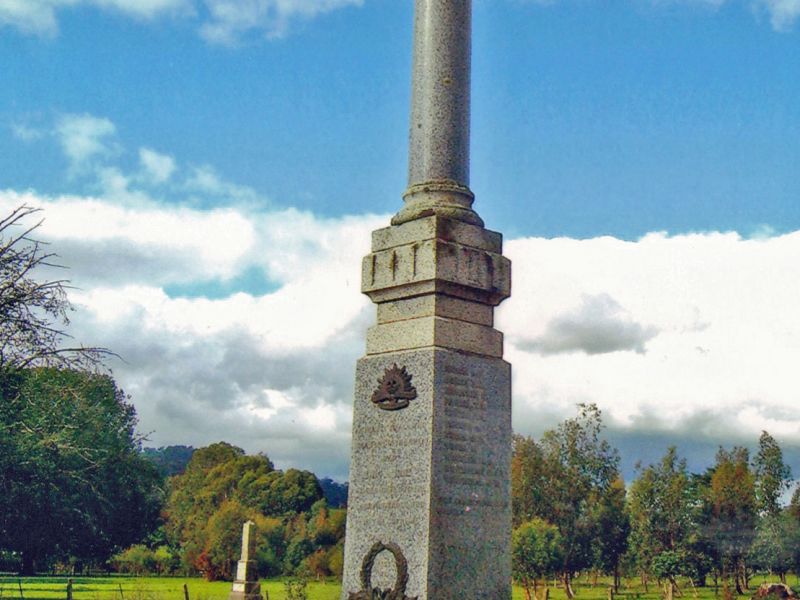John Julius Vogel
John Julius Vogel was born on the 6th of October 1879 at Tintaldra, Victoria. His father Christian Georg was 37 while his mother, Elizabeth nee Cartwright, was 35. John would have 10 siblings; Christian, Louis Joseph, William Patrick, Mary, Sydney Henry, Thomas, Ernest, John, and Leopold.
John’s father, Christian, was born in 1842 in Weinsberg, Baden-Wurttemberg, Germany. He would also be part of a large family, having nine siblings in total, although only five would live to adulthood. Passenger lists indicate a George Vogel arriving on the ship Susanne Goddefoy and arriving at Brisbane on the 17th of January 1864. It is known that he made his way down to Tintaldra and was, according to Joan Carmody in the “Early Days of the Upper Murray” a “man extremely clever with his hands. He was the blacksmith for the station horses and, as well, dentist, undertaker, and carpenter, making everything from coffins to a bullock wagon.” In 1866, at Tumbarumba, Christian married Elizabeth Cartwright, who was working in Wagga at the time.
It is not completely known when John left Australia and travelled to New Zealand. There is a record of a tailor named John Vogel becoming a naturalised New Zealander in 1902 and this could be John Julius Vogel. New Zealand electoral rolls also list a John Julius Vogel living in the Tauranga Bay of Plenty between 1911 and 1914.
John enlisted in the New Zealand Expeditionary Force on the 12th of January 1916 and was allocated the service number 11557. He listed two people as next-of-kin. His mother was the first and the second was Esau Pretty, a friend, and his employer, from Morrinsville on the North Island of New Zealand. He listed his trade as a “bushman”. At the time of enlisting John was 36 years old, 175 cm tall, 71 kg in weight, had a dark complexion, with dark brown eyes and black hair. He gave his religious denomination as Roman Catholic.
John was posted to A Company of the 12th Reinforcements for the Auckland Infantry Battalion. The unit embarked at Wellington on the 1st of May 1916 and arrived at Suez on the 9th of June 1916. Three days later, John was admitted to No. 2 Australian Stationary Hospital at tel el Kebir. Although the reason for hospitalisation is not recorded, it was sufficiently serious enough for him to be sent to the Infectious Hospital based at Shoubra, where he remained for nearly three weeks. A ten days stint at the Aolia Convalescent Home allowed him to recover and be returned to his unit on the 18th of July.
On the 27th of that month, John boarded the transport Invernia at Alexandria and sailed to England, disembarking at Southampton on the 7th of August 1916. He and other reinforcements arrived at Sling Camp on Salisbury Plain on that day. Training at Sling Camp was carried on with considerably greater vigour and for much longer daily periods than had been possible in Egypt. Three weeks later he left for France and arrived at Etaples on the 29th of August where he finally joined the 2nd Battalion of the Auckland Regiment in the field.
It was during this time that the New Zealand Division was involved in the Battle of the Somme. On the 20th of September John was wounded. He was initially sent to the No. 2 Casualty Clearing Station before being sent back to the No. 13 General Hospital in Boulogne. Although there is no mention of the nature of his wound, it was serious enough for him to be sent back to England on the SS Glengorm Castle. By 8 November, John had been admitted to No. 1 New Zealand General Hospital at Brockenhurst, Hampshire. It took over one month before his wound had sufficiently healed to allow him to be admitted to the New Zealand Convalescent Hospital at Hornchurch, east of London on the 15th of December.
It was the 11th of January before John left the Convalescent Hospital and was transferred to the New Zealand Command Depot at Codford, Wiltshire. This depot was established for soldiers who had sufficiently recovered from illness or wounds and needed to be "hardened" for further active service training. It was established in somewhat straggling fashion among the bleak, bare, undulating downs of Salisbury Plains, a few miles by road from Sling camp, Codford camp, and was not popular for its surroundings or its external attractions. John would spend two weeks before rejoining the 3rd Battalion of the Auckland Regiment and being sent back to France.
It wasn’t long before John was back in action and wounded for the second time, with a gunshot wound to the buttock. However, this time he would only spend three days at No. 3 New Zealand Field Ambulance before being discharged back to his unit.
On the 10th of April 1918, he was transferred to C Company, 4th Battalion of the 3rd Rifle Brigade. Two months later, on the 9th of May 1918, six months short of the end of the war and nearly two and a half years of being in uniform, tragedy struck. Somehow, John accidentally discharged his rifle, killing him instantly. John’s name appears on the Grevillers (New Zealand) Memorial, Grevillers British Cemetery, Pas-de-Calais, France. There is no mention of a gravesite for John and it is quite possible that his original grave was destroyed during the heavy fighting when the advancing German Army retook the village of Grevillers during their final offensive in 1918.
John is remembered at the Auckland War Memorial Museum World War 1 Hall of Memories, the Grevillers (New Zealand) Memorial and the Cudgewa War Memorial. For his service, he was awarded the British War Medal and the Victory medal.
 Stephen Learmonth
Stephen Learmonth